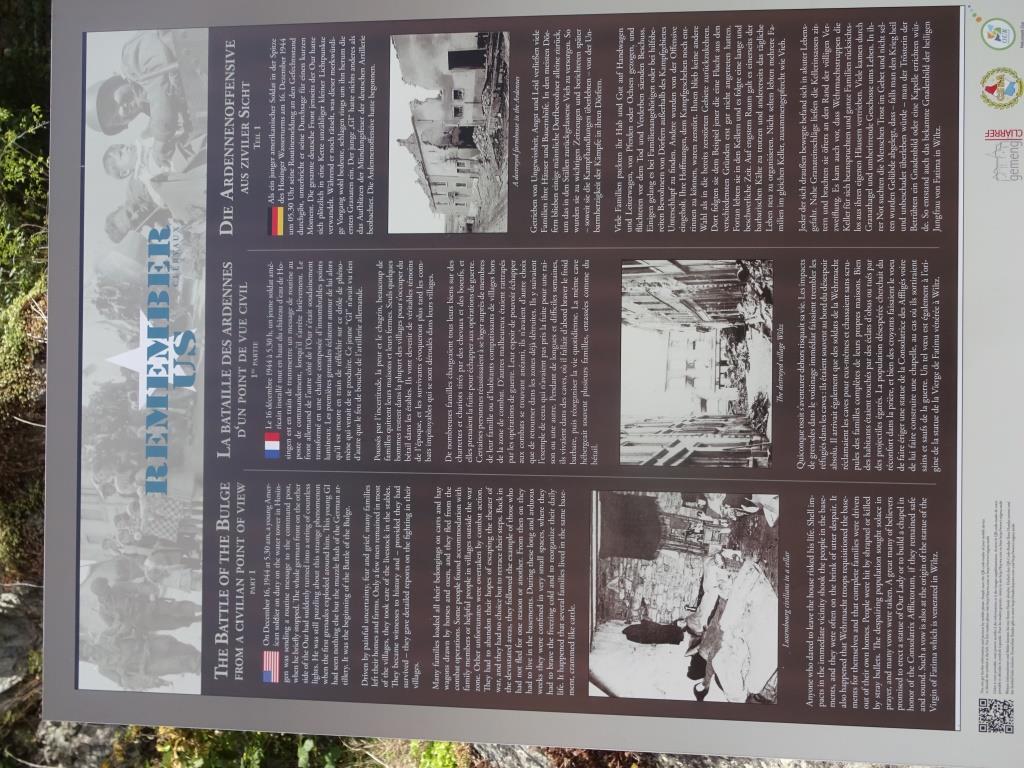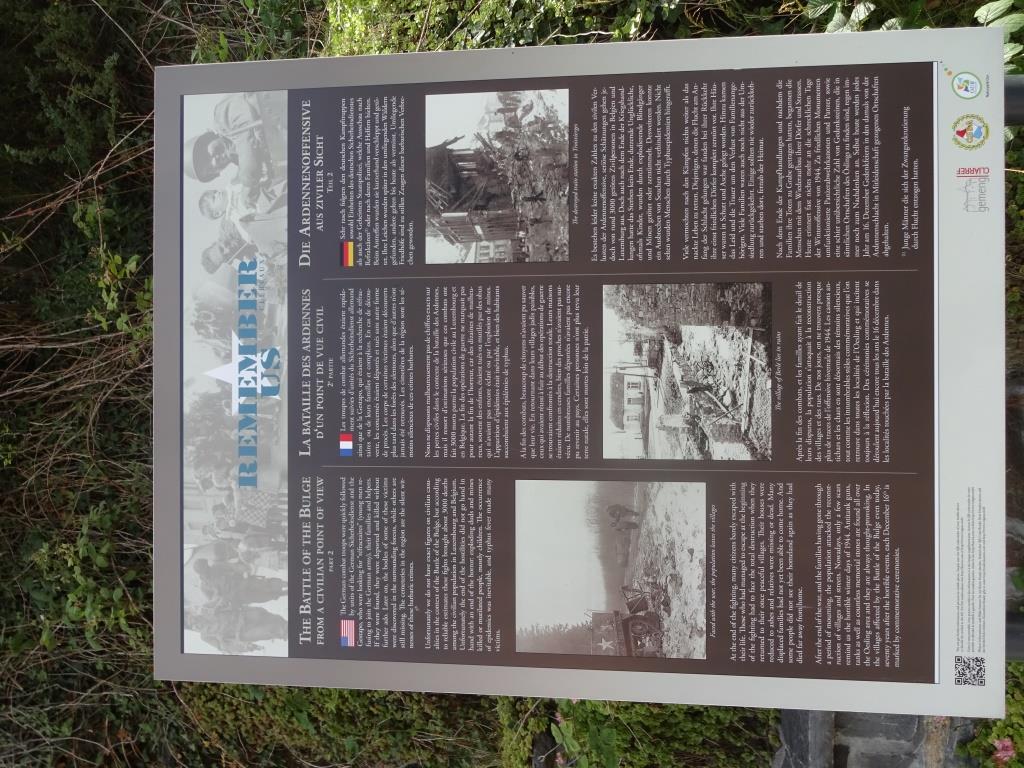Bulge Information panels
Details:
On the north side of the Clervaux castle parking lot at the Place du Marche Marker A pair of framed information panels in English, French and German describing the actions in the area from a civilian point of view
Monument Text:
R E M E M B E R
CLERVAUX
U S
1st column in English:
THE BATTLE OF THE BULGE
FROM A CIVILIAN POINT OF VIEW
PART 2
The German combat troops were quickly followed by units of the German Sicherheitsdienst and the Gestapo, who were looking for "refractaires" (young men refusing to join the German army), their families and helpers. If they were found, they were deported and killed without further ado. Later on, the bodies of some of these victims were discovered in the surrounding forests, while others are still missing. The cemeteries in the region are the silent witnesses of these barbaric crimes.
Unfortunately we do not have exact figures on civilian casualties in the context of the Battle of the Bulge, but according to reliable estimates these fights brought about 3000 deaths among the civilian population in Luxembourg and Belgium. Unfortunately the end of the hostilities did not go hand in hand with an end of the horror: exploding duds and mines killed or mutilated people, mostly children. The occurrence of epidemics was inevitable, and typhus fever made many victims.
(-picture here-)
Faced with the war, the population leaves the villages
At the end of the fighting, many citizens barely escaped with their life. Those who had managed to escape at the beginning of the fighting had to face the total destruction when they returned to their once peaceful villages. Their houses were reduced to ashes and relatives were missing or dead. Many displaced families had not yet been able to come home. And some people did not see their homeland again as they had died far away from home.
After the end of the war, and the families having gone through a period of mourning, the population attacked the reconstruction of villages and streets. Nowadays, only a few scars remind us the horrible winter days of 1944. Antitank guns, tanks as well as countless memorial stones are found all over the Oesling area and they are always thought-provoking. In the villages affected by the Battle of the Bulge even today, seventy years after the horrible events, each December 16th is marked by commemorative ceremonies.
2nd column in French:
LA BATAILLE DES ARDENNES
D'UN POINT DE VUE CIVIL
2E PARTIE
Les troupes de combat allemandes étaient rapidement suivies d'unités du Sicherheitsdienst allemand ainsi que de la Gestapo, qui étaient à la recherche de réfractaires ou de leurs familles et complices. En cas de découverte, les concernés étaient déportés et tués sans autre forme de procès. Les corps de certaines victimes étaient découverts plus tard dans les forêts des alentours, alors que d'autres n'ont jamais été retrouvés. Les cimetières de la région sont les témoins silencieux de ces crimes barbares.
Nous ne disposons malheureusement pas de chiffres exacts sur les pertes civiles dans le contexte de la bataille des Ardennes, mais il ressort d'estimations sérieuses que ces combats ont fait 3000 morts parmi la population civile au Luxembourg et en Belgique. La fin des opérations de guerre ne marquait pas pour autant la fin de l'horreur, car des dizaines de malheureux, souvent des enfants, étaient tués ou mutilés par des obus qui n'avaient pas encore éclaté ou par l'explosion de mines. L'apparition d'épidémies était inévitable, et bien des habitants succombaient aux épidémies de typhus.
A la fin des combats, beaucoup de citoyens n'avaient pu sauver que leur vie. En retournant dans leurs villages jadis paisibles, ceux qui avaient réussi à fuir au début des opérations de guerre se trouvaient confrontés à la destruction totale. Leurs maisons étaient réduites en cendres, bien des proches n'avaient pas survécu. De nombreuses familles déportées n'avaient pas encore pu revenir au pays. Certaines personnes n'ont plus revu leur terre natale, elles sont mortes loin de la patrie.
(-picture here-)
The village of Berlé lies in ruins
Après la fin des combats, et les familles ayant fait le deuil de leurs disparus, la population s'attaquait à la reconstruction des villages et des rues. De nos jours, on ne trouvera presque plus de traces de l'offensive hivernale de 1944. Les canons antichars et les chars en sont désormais des témoins silencieux, tout comme les innombrables stèles commémoratives que l'on retrouve dans toutes les localités de l'Oesling et qui incitent toujours à la réflexion. Des cérémonies commémoratives se déroulent aujourd'hui encore tous les ans le 16 décembre dans les localités touchées par la bataille des Ardennes.
3rd column in German:
DIE ARDENNENOFFENSIVE
AUS ZIVILER SICHT
TEIL 2
Sehr rasch folgten den deutschen Kampftruppen sowohl Einheiten des deutschen Sicherheitsdienstes als auch der Geheimen Staatspolizei, welche Ausschau nach Refraktären(1) oder nach deren Familien und Helfern hielten. Beim Antreffen wurden sie kurzerhand verschleppt und getötet. Ihre Leichen wurden später in den umliegenden Wäldern gefunden, andere gelten bis heute als vermisst. Umliegende Friedhöfe sind zu stillen Zeugen dieser barbarischen Verbrechen geworden.
(-picture here-)
The destroyed train station in Troisvierges
Es bestehen leider keine exakten Zahlen zu den zivilen Verlusten der Ardennenoffensive, seriöse Schätzungen gehen jedoch von rund 3000 getöten Zivilpersonen in Belgien und Luxemburg aus. Doch auch nach dem Ende der Kriegshandlungen hatte das Sterben kein Ende, dutzende Unglückliche, oftmals Kinder, wurden durch explodierende Blindgänger und Minen getötet oder zerstümmelt. Desweiteren konnte ein Ausbrechen von Seuchen nicht verhindert werden. Nicht selten wurden Menschen durch Typhusepidemien hingerafft.
Viele vermochten nach den Kämpfen nichts weiter als das nackte Leben zu retten. Diejenigen, denen die Flucht am Anfang der Schlacht gelungen war fanden bei ihrer Rückkehr ihre einst friedlichen Dörfer komplett zerstört vor. Ihre Häuser waren in Schutt und Asche gelegt worden. Hinzu kamen das Leid und die Trauer um den Verlust von Familienangehörigen. Viele Familien waren auch noch nicht aus der Umsiedlung zurückgekehrt. Einige sollten nie wieder zurückkehren und starben dort, fernab der Heimat.
Nach dem Ende der Kampfhandlungen und nachdem die Familien ihre Toten zu Grabe getragen hatten, begannen die Menschen mit dem Wiederaufbau ihrer Dörfer und Strassen. Heute erinnert fast nichts mehr an die schrecklichen Tage der Winteroffensive von 1944. Zu friedlichen Monumenten umfunktionierte Panzerabwehrkanonen und Panzer, sowie eine schier unübersichtliche Zahl von Gedenksteinen, die in sämtlichen Ortschaften des Öslings zu finden sind, regen immer noch zum Nachdenken an, Selbst heute werden jedes Jahr am 16. Dezember Gedenkfeiern in den damals von der Ardennenschlacht in Mitleidenschaft gezogenen Ortschaften abgehalten.
(1) Junge Männer die sich der Zwangsrekrutierung durch Flucht entzogen hatten.


